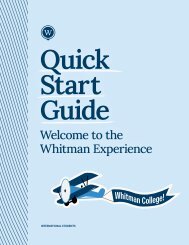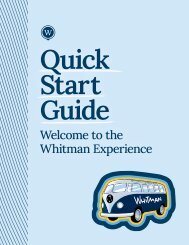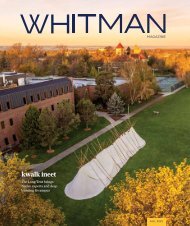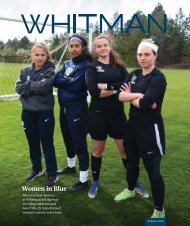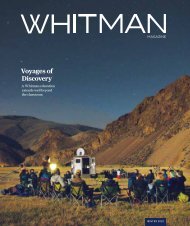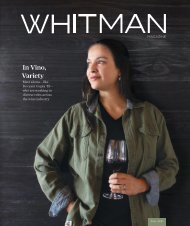Whitman College Undergraduate Conference Program 2020
Whitman College 2020 Undergraduate Conference Program
Whitman College 2020 Undergraduate Conference Program
You also want an ePaper? Increase the reach of your titles
YUMPU automatically turns print PDFs into web optimized ePapers that Google loves.
POSTER SESSION<br />
My data suggest that genes encoding metabolic enzymes<br />
including aldehyde dehydrogenase, phenylacetate-CoA<br />
oxygenase/reductase and phosphotransferase are important<br />
for promoting infection in our model. Future studies will<br />
investigate the deactivation or attenuation of these virulence<br />
factors to prevent or disrupt infection of onions by B. cepacia.<br />
Faculty Sponsor: Elizabeth Danka<br />
SARA FEDERMAN, Access to Mental Health Care in<br />
Walla Walla County<br />
In the United States, half of the 60 million individuals<br />
living with a mental health condition receive no treatment.<br />
Compared to other forms of care, mental health care remains<br />
more difficult to access for the majority of Americans.<br />
Mental health stigma, fragmented mental health care<br />
delivery systems, inadequate insurance coverage for mental<br />
health, lack of culturally competent providers and high<br />
costs are among the many barriers to care. In response to<br />
this prevalence of unmet mental health needs, Walla Walla<br />
County officials have identified increased access to mental<br />
health care as a community health goal. My qualitative study<br />
examines specific factors that limit access to mental health<br />
care in Walla Walla and how these factors vary across sociodemographic<br />
groups. Based on interviews with individuals<br />
who have sought local mental health services, my study<br />
compares costs, coverages and attitude-related barriers that<br />
limit access to mental health care in Walla Walla.<br />
Faculty Sponsor: Tom Armstrong<br />
LIAN GAMBLE, Assessing Directional Deficiencies in Gaze Gain in the<br />
Saccade Task Relative to Impact Location in Concussed <strong>College</strong> Athletes<br />
In the United States, mild traumatic brain injuries (mTBI),<br />
also known as concussions, impact 3.8 million athletes<br />
annually. Concussions may be caused by head or body<br />
impact which can result in harmful biomechanical forces<br />
and brain acceleration-deceleration patterns. Unfortunately,<br />
many concussions go undiagnosed due to limited diagnostic<br />
tools. These methods rely on self-reported symptoms and<br />
lack consistent, definitive results. However, quantitative tests<br />
for oculomotor function have recently been used to identify<br />
cerebral dysfunction because oculomotor circuitry is widely<br />
distributed in the brain. Using video-oculography (VOG), gaze<br />
gain (a measure of accuracy) was shown to be a good marker<br />
for mTBI diagnosis. This research expanded on previous<br />
studies by examining the effects of concussion on combined<br />
eye-head gaze shifts in the saccade task to determine if gaze<br />
gain could localize the site of brain injury.<br />
Faculty Sponsor: Thomas Knight<br />
NADIA GANJOLOO, DREW CONKIN, Regiospecificity<br />
and Kinetic Measurements of Type II Hydroquinone Ring-Cleaving<br />
Dioxygenase PnpC1C2<br />
Microbes have developed ways to introduce synthetic<br />
chemicals into their metabolic pathways as a source of<br />
energy. One such compound is p-nitrophenol, which is used<br />
in biocides, dyes and drug intermediates. P-nitrophenol<br />
is toxic, accumulating in soil and groundwater with<br />
insignificant natural degradation. PnpC1C2 is an enzyme<br />
found in the catabolic pathway of p-nitrophenol in<br />
Pseudomonas putida DLL-E4. This previously uncharacterized<br />
enzyme is a type II hydroquinone ring-cleaving dioxygenase,<br />
part of the larger category of ring-cleaving dioxygenases. As<br />
protein structure determines its function, regiospecificity and<br />
kinetic measurements of PnpC1C2 breaking down different<br />
substrates were taken to investigate the structure of the<br />
enzyme. The mechanistic pathway of the substrate becoming<br />
the product is dependent on the enzyme’s active site. A better<br />
understanding of this mechanism sheds light into the other<br />
type II hydroquinone ring-cleaving dioxygenases.<br />
Faculty Sponsor: Tim Machonkin<br />
ALEX GERBER, The Effects of Solar Radiation on Bluebunch Wheatgrass<br />
Bluebunch wheatgrass (Pseudoroegneria spicata) is a<br />
perennial bunchgrass native to Eastern Washington.<br />
Recently, its numbers have been on the decline. At Spring<br />
Gulch in the Wallula Gap Biological Station, bluebunch is<br />
much more common on north-facing slopes compared to<br />
south-facing slopes. The lower density of bluebunch on southfacing<br />
slopes may be due to a greater exposure to solar radiation<br />
and, in turn, higher temperatures. If this is correct, then I<br />
expect climate change will further exacerbate the decline in<br />
bluebunch populations. To test this hypothesis, my research<br />
group erected shaded plots to reduce solar radiation and<br />
temperature. I compared the germination and seedling survival<br />
of bluebunch in these shaded plots to those of unshaded control<br />
plots. If seedlings are more successful in shaded rather than<br />
unshaded plots, this suggests climate change may drive<br />
bluebunch toward extinction in the Columbia Basin.<br />
Faculty Sponsor: Tim Parker<br />
KACEY GODWIN, Macrocyclic Peptides for the Treatment of<br />
Multiple Myeloma<br />
The human 20S proteasome is a complex enzyme that serves<br />
regulatory and metabolic functions by helping to break<br />
down proteins in the body. For that reason, many scientists<br />
have focused on the proteasome for cancer research by<br />
investigating therapeutic agents that can inhibit its activity.<br />
Unfortunately, many drugs that are used in a clinical setting<br />
present serious side effects such as cardiac arrest. My research<br />
works toward the goal of developing compounds that do not<br />
bind to other enzymes and thereby pose fewer health risks to<br />
patients. My molecule of study is a structural hybrid of two<br />
proteasome inhibitors: TMC-95A, a natural fungal product<br />
and carfilzomib, an FDA-approved drug for treating multiple<br />
myeloma. My research demonstrates that this peptide with a<br />
macrocyclic framework, in combination with other molecular<br />
modifications, is an effective inhibitor design.<br />
Faculty Sponsor: Marion Götz<br />
THOMAS HARRIS, A Data Science Approach to Signal Processing in<br />
Laser Interferometer Gravitational-Wave Observatory (LIGO) Data<br />
The goal of the Laser Interferometer Gravitational-Wave<br />
Observatory (LIGO) detectors is to detect faint ripples in<br />
spacetime caused by the merger of massive compact objects,<br />
like black holes and neutron stars, using a Michelson<br />
interferometer with Fabry-Pérot cavities in the 4-kilometer<br />
arms. Each detector site has ~250,000 “channels” that<br />
track the state of the interferometer, record data from<br />
optical equipment like photodiodes, monitor the physical<br />
environment through seismometers/magnetometers and<br />
more. Channel records can help us track down sources of<br />
unwanted signals that affect the calculated gravitational<br />
wave strain and interfere with searches for real gravitational<br />
waves. Automated signal processing programs such as FScan<br />
generate an overwhelming amount of information about<br />
various channels. I am creating programs to sift through these<br />
data to find unusually high long-term coherences between sets<br />
of channels and the gravitational wave strain signal. My goal is<br />
to support work onsite by identifying mystery noise sources.<br />
Faculty Sponsor: Frederick Moore<br />
ABBY HILL, Post-Disturbance Analysis of a Semi-Arid Plant Community<br />
The Interior West of North America is dominated by semi-arid<br />
grassland ecosystems. Over the past century, these grasslands<br />
have experienced an increase in disturbance due to wildfire,<br />
livestock grazing and erosion, among other factors. After<br />
disturbance, it can be difficult for native perennial species<br />
to reestablish themselves, due in part to the encroachment<br />
of invasive annual grasses. To learn more about grassland<br />
communities post-disturbance, my colleagues and I simulated<br />
disturbance at seventeen sites on a north-facing slope at<br />
Spring Gulch, Washington. We examined the differences in<br />
composition and size of perennial plant species between<br />
disturbed and control plots. After four years of disturbance,<br />
perennial species composition was shown to differ between<br />
the two plot types and perennial grasses were found to be<br />
much smaller in disturbance plots. These findings suggest<br />
that grassland ecosystems take longer than four years to<br />
recuperate after disturbance.<br />
Faculty Sponsor: Tim Parker<br />
JACLYN HODGSON, T-Cell Receptor Immunotherapy Targeting<br />
Cancer/Testis Antigens in Pediatric Brain Tumors<br />
T-cell immunotherapy provides a method to target cancer<br />
cells using immune cells made by the body for the purpose<br />
of preventing cancer growth. For this project, I worked to<br />
identify amino acid sequences of proteins called cancer/testis<br />
antigens, which are present on the surface of pediatric brain<br />
tumor cells. These proteins are normally found only in male<br />
germ cells; when uniquely expressed by cancer cells, they<br />
provide a promising target for immunotherapy. I hypothesized<br />
that T-cells with a receptor specific to these sequences would<br />
be able to identify and kill cells expressing those amino acids.<br />
Using synthetic peptides and patient cancer cells I was able<br />
to show that the T-cells could selectively kill cells with the<br />
corresponding amino acid sequence, indicating that this<br />
could have a potential therapeutic benefit of killing cancer<br />
cells in a patient while not damaging healthy tissues.<br />
Faculty Sponsor: Jim Russo<br />
BECCA HOFFMAN, Small Organic Acids Catalyze Disjunctive Ligand<br />
Exchange Reactions<br />
Plants require various micronutrients to survive, including<br />
metals. Metals in the natural world are found in many forms<br />
that limit their bioavailability. Many metals are found bound<br />
by organic molecules called ligands. Metal bioavailability<br />
is controlled by transfer reactions between these complexes<br />
12 13





